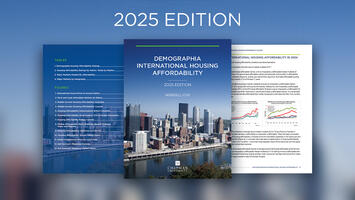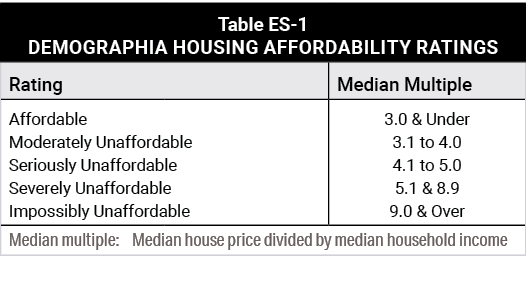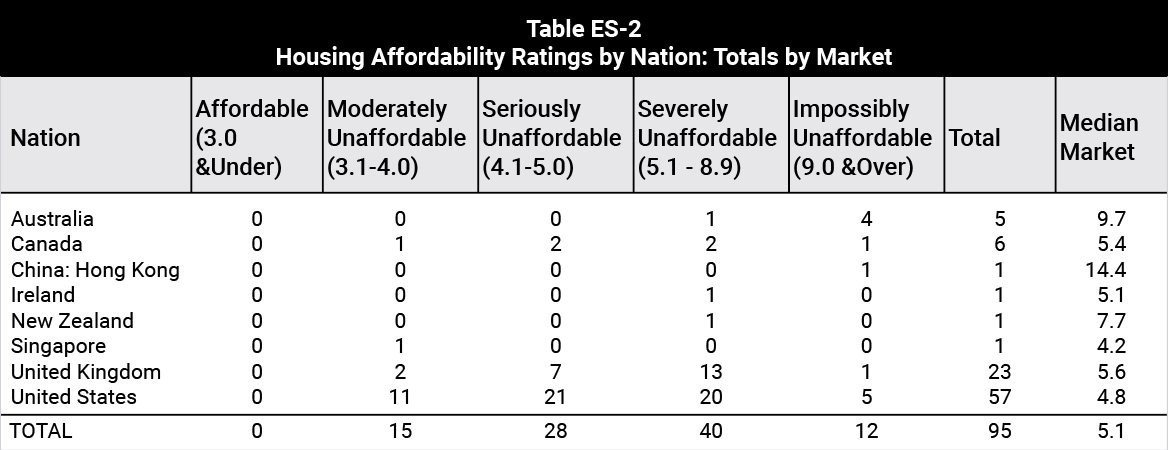
This annual report assesses housing affordability in 95 major markets across eight nations (Australia, Canada, China, Ireland, New Zealand, Singapore, United Kingdom and the, United States). The 2025 edition covers the third quarter of 2024.
Key Points
Ratings: The report uses a median price-to-income ratio (“median multiple”) to determine affordability.
 Affordability Categories: Housing markets are rated from “affordable” to “impossibly unaffordable” based on their median multiple (Table ES-1).
Affordability Categories: Housing markets are rated from “affordable” to “impossibly unaffordable” based on their median multiple (Table ES-1).
Geography: Housing markets are labor markets (which are also metropolitan areas or functional urban areas), largely defined by the “commuting shed.” Housing affordability comparisons can be made, (1) between housing markets (such as a comparison between Adelaide and Melbourne) or (2) over time within the same housing market (such as between years in Adelaide).
Variations within Nations: The report emphasizes that affordability often varies significantly between markets within the same country. National averages aren’t always representative.
Housing affordability in 2024 is summarized by nation in Table ES-2.
Details on housing affordability for all 95 markets, displayed by median multiple, are provided in Table 3 and by geography in Table 4 of the full report.
For the fifth year in a row, Pittsburgh (PA), in the United States, was the most affordable market in Demographia International Housing Affordability. This year the Pittsburgh median multiple was 3.2, which is moderately unaffordable.
The least affordable market in Demographia International Housing Affordability in 2024 was Hong Kong, with a median multiple of 14.4, followed by Sydney at 13.8, San Jose, at 12.1, Vancouver at 11.8, Los Angeles at 11.2, Adelaide at 10.9, Honolulu at 10.8, San Francisco at 10.0, Melbourne at 9.7, San Diego and 9.5, Brisbane at 9.3 and Greater London at 9.1. All of these markets are rated impossibly unaffordable.
Existential Threat to Middle-Income Households
Among high-income nations, middle-income homeownership was once widespread, with house prices aligned with incomes. Since the 1990s, however, prices have surged —especially in
markets governed by urban containment strategies early (e.g., San Francisco, Sydney, London)— with homes now costing 9–15 times household income.
This shift is linked to the international planning orthodoxy, which restricts urban expansion through greenbelts, urban growth boundaries (UGBs), rural zoning, and compact city policies. While intended to increase density and sustainability, these policies have severely limited land supply, raising land and housing costs and making housing unaffordable for the middle class.
Nearly all severely unaffordable housing markets follow the urban containment model. The resulting land scarcity inflates prices, particularly near UGBs. This pattern, rooted in the UK’s 1947 Town and Country Planning Act, has spread virtually around the world.
Purpose of Urban Planning: Urban planning is meant to improve lives. As Jane Jacobs said: “If planning helps people, they ought to be better off as a result, not worse off.” Yet urban containment has made many people worse off, by virtue of its association with substantially worsened housing affordability.
Current planning approaches emphasize multifamily housing and other densification while restricting new detached homes at the fringe—strategies that helped create today’s crisis.
Counterurbanization: Middle-income households are increasingly leaving expensive markets for more affordable places—a trend especially visible in Canada and the U.S. These moves reflect long-term structural problems. People are “voting with their feet,” to obtain the housing denied them in markets with deteriorated housing affordability. Without major reform, this migration seems likely to continue.
Elaboration and sources are in the full report. Click here to read and download the full report.
Wendell Cox is principal of Demographia, an international public policy firm located in the St. Louis metropolitan area. He is a Senior Fellow with Unleash Prosperity in Washington and the Frontier Centre for Public Policy in Winnipeg and a member of the Advisory Board of the Center for Demographics and Policy at Chapman University in Orange, California. He has served as a visiting professor at the Conservatoire National des Arts et Metiers in Paris. His principal interests are economics, poverty alleviation, demographics, urban policy and transport. He is author of the annual Demographia International Housing Affordability Survey and author of Demographia World Urban Areas.
Mayor Tom Bradley appointed him to three terms on the Los Angeles County Transportation Commission (1977-1985), which was a predecessor agency to the Los Angeles County Metropolitan Transportation Authority (Metro). Speaker of the House Newt Gingrich appointed him to the Amtrak Reform Council, to complete the unexpired term of New Jersey Governor Christine Todd Whitman (1999-2002). He is author of War on the Dream: How Anti-Sprawl Policy Threatens the Quality of Life and Toward More Prosperous Cities: A Framing Essay on Urban Areas, Transport, Planning and the Dimensions of Sustainability.
Image and charts are from the report. Charts by the author; cover image for the report from the GPA Archive, Carol M. Highsmith collection and used under CC 2.0 License.













